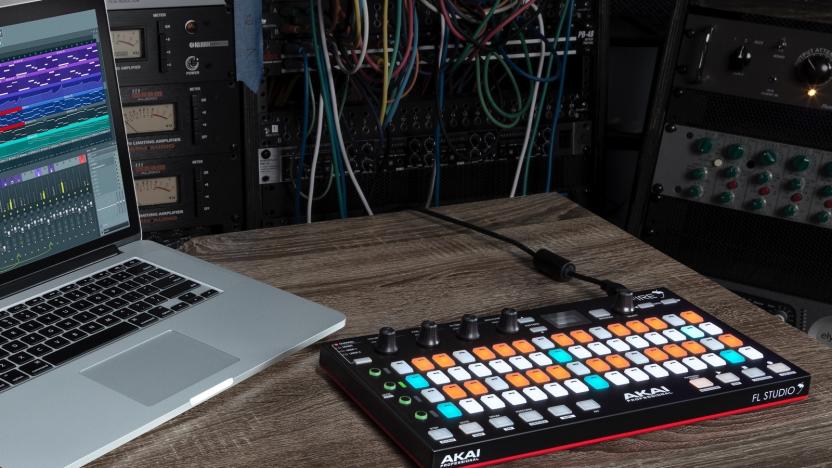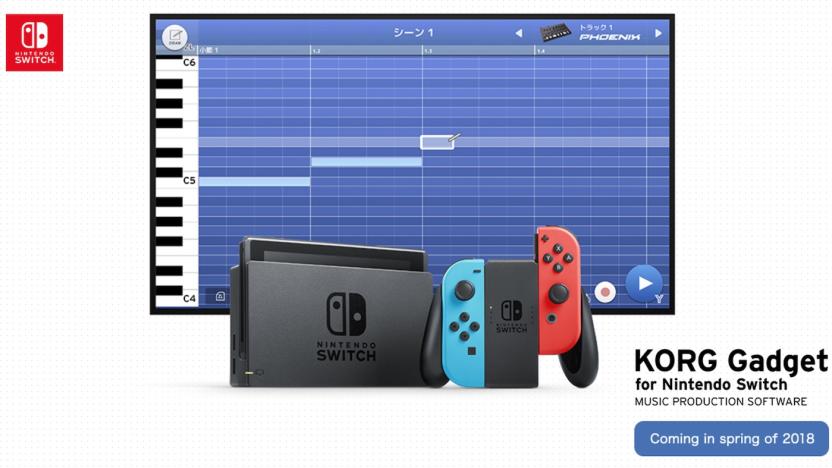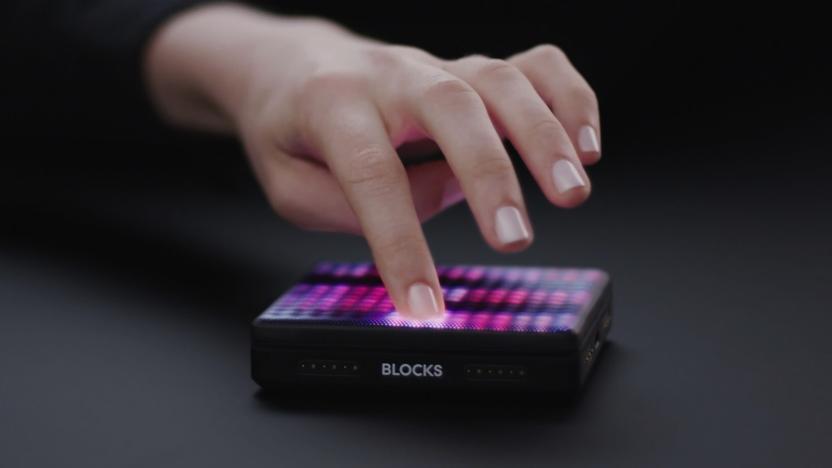MusicProduction
Latest

FL Studio gets its own dedicated music-making hardware
The favorite DAW (digital audio workstation) of producers like Metro Boomin and Mike Will Made It finally has a piece of hardware to call its own. Ableton got its first dedicated hardware controller way back in 2009. And Pro Tools has had them since... well honestly I don't even know, but long before that even. FL Studio though, despite its popularity, has had to make do with generic MIDI controllers until now. The Akai Professional Fire changes all of that.

The Sensel Morph trackpad is a digital creative's dream
Our computers have become indispensable creation tools, but let's face it: The decades-old keyboard-and-mouse combo aren't the best way to edit video, draw or play music. That's where the Sensel Morph comes in. It's a pressure-sensitive touchpad that lets you swap in multiple overlays and instantly switch gears between video editing, painting, music creation, gaming, coding and other tasks. There are already a number of media controllers out there, and I've tested a couple, including the Palette Gear and the Loupedeck. But after using the Sensel Morph for a couple of days, I have to say that it really stands out from the pack. It's the most clever and versatile device I've tested, and though it's a bit expensive at $299, plus more for extra overlays, it's worth it for artists, musicians and editors, especially if you wear more than one of those hats.

Korg's Gadget music production app is coming to Nintendo Switch
It looks like Korg is bringing its Gadget music-making app to the Nintendo Switch next spring. There isn't a ton known about it at the moment, but given the name, it seems like it's a port of the synth company's end-to-end iOS and Mac music production suite. According to Japanese publication 4Gamer (translated), the software will support motion controls and work with the Joy-con. More than that, up to four people will apparently be able to "play" it.

Roli makes its Blocks music-making module more responsive
British music company Roli introduced an affordable, innovative music-making gadget last year called Roli Blocks. It's a set of modular synth controllers that can snap together and connect via Bluetooth to your iOS device. Roli is now updating the iOS app, Noise, and updating its surface controller, the Lightpad M.

Sound Taxi composes music from London city buzz, doesn't even take a fare
What you see above isn't just another shameless car stereo project, but a black cab that turns the hustle and bustle of city noise into music. The Sound Taxi toured London last week collecting ambient sound pollution with a roof-mounted mic, recycling it through production software and then pumping out real-time mixes on its army of speakers and horns. The mobile disco was a collaboration between headphone company AiAiAi and Yuri Suzuki, with Mark McKeague providing the back-end wizardry which turned clamor into samples into tracks. If you'd like to hear the fruits of their labor, then head over to the Make The City Sound Better website (sourced below) for some uploaded examples of London street beats.

Akai makes intentions clear with MPC Renaissance (video)
While the majority of technology execs are packing their cases for Vegas, for some it's all about Anaheim. Akai is clearly ramping up its NAMM campaign, outing the latest in its legendary MPC series: the Renaissance. While the new boy is no dumb controller -- it packs a full audio interface, USB hub and lots of I/O -- for the first time the MPC gets dedicated external software. Sound familiar? Well yes, it's no doubt a direct response to the popular Maschine hardware / software combo from Native Instruments, but Akai isn't just playing catch-up here. The new hardware includes a "vintage" mode that recreates some of that legendary MPC3000/60 crunch, and the standalone software comes with a massive sound library, instant VST mapping (so you can work with all your third-party synths) as well as the option to run in VST / AU / RTAS mode itself. If you're worried about the possible implications of a "tethered" MPC, take a peek at the promo video over the jump, which should soon allay your fears.

Steinberg CMC modular USB controllers, stack 'em how you want 'em (video)
The mere mention of the word modular is usually enough to get any self-respecting music geek hot under the collar, so when Steinberg announced its latest stackable collection of dedicated USB music production controllers, hardware fans will have felt a collective twitch of excitement. Specifically built for its much loved Cubase and Nuendo programs, each of the six units has its own speciality, and has been designed to let you get your tactile funk on, be it mixing melodies or mashing in beats. Plonk up to nine of these sleek, luminous lovelies on your desk for the music control surface of your dreams, but with no mention of price just yet, you might want to keep the plastic wrapped up until they hit the stores in October. Ogle the video after the break for the full company promo.

FL Studio Mobile lands on iOS, more indie rap albums to be produced while commuting
Dream no longer friends, FL Studio Mobile is here for your iOS device of choice. The iPhone and iPod touch version is being offered for $15, while the more expansive HD edition for the iPad is fetching $20 -- but both will see their price climb another $5 after the introductory sale is over. As mentioned you'll be able to pass project files back and forth between the desktop and mobile apps, though the iDevices lack support (and the muscle power) for VST instruments. It also appears the scope of the sequencer had to be scaled back from 128 tracks to 99, but that should be more than enough to keep you tapping out beats like 9th Wonder while riding the train. Hit up the source links to download the portable production suite and check out the gallery below. %Gallery-126831%

FL Studio coming to iOS (unicorns, leprechauns, phat beats to follow)
We thought it was an impossible dream, like world peace or a second season of My So Called Life, but we finally have the answer to the immortal question: "When will FL Studio be available on operating systems besides Windows?" The answer? "Soon." That's right -- FL Studio Mobile is coming to all of your favorite iOS devices, and all things considered, it looks pretty, pretty good. 128-track sequencer, step sequencer for individual MIDI clips, a mess of drum loops, reverb, delay, equalizer, amp, and filter effects... how can you find fault with that? And when you get back to your PC, your mobile project can be mixed down to wav, exported to MIDI, or the session file can be loaded right in the desktop version of the software. Not bad, eh? At the very least, it sounds like it will give GarageBand for the iPad a run for its money. Sadly, we don't have a street date for the app right this moment, but you can get a pretty good look at what's in store in the video after the break.

iPad / MIDI hardware options detailed, awesome (video)
If you have an iPad and you're looking for ways to incorporate it into your music-making setup, the kids at Create Digital Music have put together a handy guide to the wonderful world of iPad / MIDI integration. Featuring the Apple Camera Connection Kit (which plays well with MIDI USB, by the way), various apps, and quite a bit of video, there should be plenty to keep the music-lovin' geek entertained. Our favorite video, which we attached after the break, features an unholy collaboration between the FunkBox iPad app and a x0xb0x sequencer / synth. But what are you waiting for? Hit the source link to get started.

Korg rolls out slimmed down nanoSeries2 USB controllers
Korg's original nanoSeries USB controllers may have garnered some mixed reviews when they were released back in 2008, but the company's now back with some new and improved models that seem to address at least some of those complaints. As before, the lineup includes three different models: the nanoKEY2, nanoPAD2 and nanoKONTROL2, which can either be used on their own or paired up together. In addition to a slimmer design for each, all three are available in your choice of black or white, and it sounds like Korg has moved away from the plasticky, QWERTY keyboard feel that plagued the previous models, with the nanoKEY2 in particular described as having the same "great-feeling 'touch' that Korg has developed for its professional MIDI keyboards." Still no word on pricing or availability, but you can find all the rest of the key details at the link below.

iKlip attaches iPad to mic stand, musicians rejoice
If you're a musically-inclined techie, you probably noticed the introduction of IK Multimedia's iKlip late last year, we certainly did. And since several of you probably received an iPad last month, we thought it was worth a mention today. Especially for the musicians out there. Musicians have embraced the iPad from the beginning, but have struggled to find a practical way to use it to read music while playing an instrument. Thankfully, IK Multimedia has come up with an obvious yet effective solution to this predicament: the iKlip. The light weight, multi-angle iKlip attaches your iPad to just about any microphone stand with ease -- vertically or horizontally, with access to all your iPad's buttons. Built with "...thermoplastic molded components for extreme durability and secure holding abilities under the most demanding situations," you'll have no further difficulty reading a musical score while playing your instrument, tweaking settings for your guitar effects app or even singing the lyrics to your favorite karaoke song. Hey, if you're a public speaker, this is probably worth you checking out, too. The iKlip is available for US$39.99 from IK Multimedia's website here. [Thanks to commenter hankermac for pointing this out.]

Apple introduces MIDI to iOS 4.2, iPads the world o'er get ready to rave
Although musicians were quick to pick up on the iPad's possibilities as a control surface, the audio production corner of the App Store is still overwhelmingly devoted to things like guitar amp models and soft synths -- that's because until recently there was no way to send MIDI commands from iOS (not that some folks didn't figure out workarounds). That's why we were excited to hear about the appearance of MIDI APIs in iOS 4.2. What does this mean for all of you would-be Brian Enos? The gang over at Create Digital Music have put together a handy guide to what we might expect from a world where all out iOS devices can communicate via MIDI, whether through the USB cable or over WiFi -- and it is a brave new world, indeed. Intrigued? We were too! And we were pleased to find out that yes, the M-Audio Uno works with the iPad, and that the accelerometer can indeed be used to pitch bend. Unfortunately, we also learned that the Line 6 MIDI Mobilizer is a lot less exciting than we thought it might be (that is, until third party devs go to town on the thing). Hit the source link for all that stuff and more. Or just peep the video after the break, if you wonder what the next version of Pianist Pro holds.

Count The Beats: Moog Filtatron - a closer look
Last week, Moog Music released Filtatron, an iPhone app modeled after Moog's own analogue hardware. If you're not familiar, and you're wondering what the heck a Moog is anyway, you may be surprised to find you've probably heard one dozens of times before, performed on countless albums. Moog Music, founded by Dr. Robert Moog, is the maker of digital and analogue synthesizers like the Minimoog and the Moog Theremin (although the original Theremin was invented by Léon Theremin). A good example of a Moog synthesizer can be heard by the band Air, on their track Kelly Watch The Stars, off their album Moon Safari (Listen in at about 2:10 for what sounds like a Moog Theremin to me). Typically, Moog Synthesizers are rather expensive, being that they are hand made for a rather substantial, albeit niche market. Therefore, I can't say I've spent any time with a real Moog. As much as I'd like to say I have a couple kicking around in the spare room of my house, I don't. So, unfortunately, I don't know a great deal about the sounds of Moog hardware other than what I've heard off recordings. And, I suspect, that's how most other users will approach Filtatron, too. Thankfully, Filtatron goes a long way to helping users understand what it does and how it does it by including a built-in user guide and glossary. After you've had an initial play, I highly recommend you have a good read over these to get the most out of the app. It certainly helped me out. There's also a whole bunch of presets to show you exactly what Filtatron can do, and how to get there. At this point, you may be wondering what Filtatron actually does. In a nutshell, let me try to explain. Using its filter ladder -- a four-pole resonant ladder filter modeled after the filter found on analogue Moog hardware -- Filtatron shapes sound, giving it characteristics akin to a real Moog filter. In Filtatron, there are two different ways of using this filter. You can either shape the sound using the knobs and dials found on the main tab of the app or by using the two "hands-on" pads provided -- allowing you to swipe and move your fingers around the pads to adjust and control most of the parameters found in Filtatron. To provide further character to the sound, there's a FX module, with fully featured delay, and an amp with distortion and controlled feedback, too.

Korg nanoSERIES USB controllers unboxed, previewed
The Korg nanoSERIES line of miniature USB controllers we had a look at a few months back has finally seen the light of day, and much to our chagrin, reviews are mixed. MusicRadar singles the nanoPAD out for praise, saying the twelve drum pads feel good and the X/Y pad is a useful addition, but they seem less impressed with the nanoKONTROL and nanoKEY. The site says the faders on the former feel "short and decidedly plasticky," while they compare the keys on the latter to those of a QWERTY keyboard. If you're still interested, the nanoKey will run you £49 ($90), and the nanoKontrol and nanoPad will be £59 ($109) each. Look for these guys starting in October, and hit the read link for more details and pics.

Korg's nanoSeries shrinks your music studio
Korg really wants you to downsize your studio with its new lineup of miniature controllers, dubbed the nanoSeries. The diminutive set includes the nanoKEY (a 25-note, velocity sensitive keyboard), the nanoPAD (12 trigger pads and a touch-sensitive X/Y touchpad), and the nanoKONTROL (a mini-mixer with nine faders, nine knobs, 18 switches, and playback controls). The modular, lilliputian gear connects via USB and are all bus-powered, though we're hoping they've got other power options so the devices can be daisy-chained. No word on pricing or availability, but you'll know when we do.[Thanks, Tom] Update: Looks like the Nano Pad, Nano Key, and Nano Kontrol should be available by this October, starting at somewhere around $100-120 US. Thanks, Tosse.

Alesis iMultiMix 8 USB mixer records directly to iPod
We've seen a number of mixers incorporating iPods around here -- from the four-track Belkin TuneStudio to DJ models from Numark and iTRAX to gimmicky toys from MusicJam and others -- but none quite as polished as the upcoming eight-track iMultiMix 8 USB from Alesis, which combines 48-volt phantom power, 100 28-bit digital effects, and four high-gain preamps into a pretty snazzy-looking mini studio. Once your get your creations down pat, they can be easily transferred to your PC through iTunes, where they'll be converted into 16-bit / 44.1kHz or 48kHz recordings. Wired's Gadget Lab tells us to expect this sometime in the fall for around $500, so aspiring super producers take note.[Via Gadget Lab]

Logic for Intel Macs at NAMM
If you haven't made up your mind that Intel chips will "save" the Mac platform, Apple demoed the Intel-native version of Logic Pro 7 at NAMM today. How fast is it? Let's just say I'm going to have to call that PowerBook of yours - yeah, the shiny 17" version - a paperweight. Don't go planning any Grammy's, that's for sure. The Intel version of Logic is doing things that weren't even possible on PPC versions. To quote Bob Hunt, as he wowed the NAMM'ers with a session full of video and high-end effects: "None of these sessions would even run on a PowerBook." It's nice to see Apple calling it like they see it. Here's hoping the music industry hops on board. I know some indie producers jumped ship a few years ago for PC's because the hardware was cheap, and many of the audio tools they were using were getting long in the tooth. Logic Pro for Intel might just be insanely great enough for them to come back home.[Via AppleInsider]







